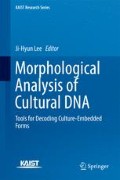Abstract
This paper presents a model for Korea’s cities that describes the characteristics of growth pattern and morphological transformation. To do so, it uses the case of ‘HanJoo (한주 韓州)’, a hypothetical in-land city on Korean Peninsula, which is developed based on a set of preliminary studies of several Korean cities. The narrative model using illustrations is intends to examine the process of four-staged developments in the central urban area: (1) walled town to regional center (675–1890); (2) town expansion via grid blocks (1890–1945); (3) industrial district and factory complex linked by inter-city highway (1946–1994); (4) new community development and massive suburban growth (1995–present). The study, anticipating further subsequent work in the future, attempts to identify the growth, change and decline mechanism of the built environment in both old and new cities. The findings can help guide decision-makers whose public actions are likely to influence a city’s development process and direction, with more informed planning alternatives within both larger city and larger region.
A set of contents included in 3. The Growth Phases of HanJoo are translated in English from [1] which was published in Korean.
Access this chapter
Tax calculation will be finalised at checkout
Purchases are for personal use only
References
Han, G. (2014). Development and transformation of Model Korean City. Journal of architectural institute of Korea, 30(10), 169–178.
Girouard, M. (1985). Cities and people. New Haven: Yale University Press.
Gruber, K. (1937). Die gestalt der deutschen stadt. Bibliographisches.
Morris, A. (1994). A history of urban form. London: Longman Scientific and Technical.
Kelly, B. (2004). The story of paradigm university: A mythical look at the evolution of campus planning. Baltimore: Ayers Saint Gross.
Fisher, B., et al. (2004). Making the urban waterfront. Washington: Urban Land Institute.
Lynch, K. (1960). The image of the city. Cambridge: The MIT Press.
Steele, P., & Noon, S. (2007). A city through time. London: Dorling Kindersley Publishers.
Han, G., & Shin, Y. (2016). 도시에 서다: Development of Korean city. Seoul: SangSang Publisher.
Author information
Authors and Affiliations
Corresponding author
Editor information
Editors and Affiliations
Rights and permissions
Copyright information
© 2017 Springer Nature Singapore Pte Ltd
About this chapter
Cite this chapter
Han, G. (2017). Imagining the Paths of Cities: A Case of Korean City. In: Lee, JH. (eds) Morphological Analysis of Cultural DNA. KAIST Research Series. Springer, Singapore. https://doi.org/10.1007/978-981-10-2329-3_9
Download citation
DOI: https://doi.org/10.1007/978-981-10-2329-3_9
Published:
Publisher Name: Springer, Singapore
Print ISBN: 978-981-10-2328-6
Online ISBN: 978-981-10-2329-3
eBook Packages: Earth and Environmental ScienceEarth and Environmental Science (R0)

